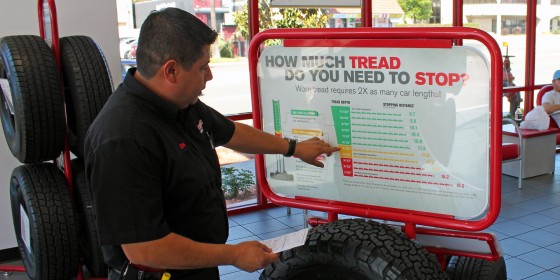When it comes to checking tire tread, there are a number of methods that can help you know if it’s time to replace a tire. Heavily worn tread will prevent a tire from performing as designed and can lead to unsafe driving conditions. One of the simplest, most common ways to check tread depth requires nothing more than a penny and a few moments of your time.
In the United States, tire tread depth is measured in 32nds of an inch. New tires typically come with 10/32” or 11/32” tread depths, and some truck, SUV and winter tires may have deeper tread depths than other models. The U.S. Department of Transportation recommends replacing tires when they reach 2/32”, and many states legally require tires to be replaced at this depth.
The idea of the penny test is to check whether you’ve hit the 2/32” threshold. Here’s how it works:
Place a penny between the tread ribs on your tire. A “rib” refers to the raised portion of tread that spans the circumference of your tire. Tire tread is composed of several ribs.
Turn the penny so that Lincoln’s head points down into the tread.
See if the top of his head disappears between the ribs. If it does, your tread is still above 2/32” , If you can see his entire head, it may be time to replace the tire because your tread is no longer deep enough.
When performing the penny tire test, remember not only to check each tire, but to check various places around each tire. Pay special attention to areas that look the most worn. Even if parts of your tread are deeper than 2/32”, you should still replace the tire when any areas fail the penny test.
Consistent wear around the whole tire is normal, but uneven tread wear could be a sign of improper inflation, wheel misalignment, or a variety of other things. If you see uneven tread wear, you should have a technician inspect your vehicle.
A simple way to check your tire tread depth is by using a tread depth gauge. You can find tire tread depth gauges at your local auto parts store. There are many models available, but an inexpensive simple graduated probe gauge will work just fine. All you have to do is stick the probe into a groove in the tread and press the shoulders of the probe flat against the tread block and read the result. All gauges should measure in both 32nds of an inch and millimeters.
You can find tire tread depth gauges at your local auto parts store. There are many models available, but an inexpensive simple graduated probe gauge will work just fine. All you have to do is stick the probe into a groove in the tread and press the shoulders of the probe flat against the tread block and read the result. All gauges should measure in both 32nds of an inch and millimeters.
Another indicator of worn out tread already lives in your tires themselves. Every performance, light truck, or medium commercial tire comes equipped with indicator bars (or wear bars) embedded between the tread ribs at 2/32”. They’re there to help you monitor tread depth and make decisions about tire replacement. Just look to see if the tread is flush with the indicator bars. If they are, it’s time to replace the tire.
While the penny tire test does deliver on what it promises – indicating whether tread has reached the legal limit – it may not be the best indicator of whether your tires are safe for the road.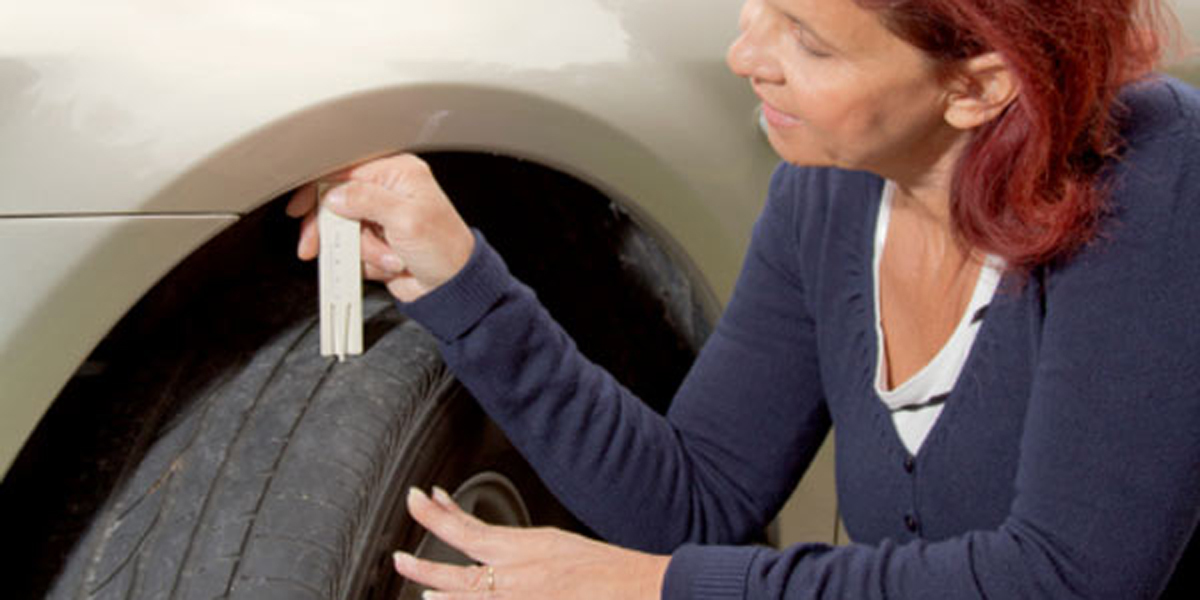 Tire performance can diminish significantly before your tread hits 2/32”. Even though the law deems fit for safe driving may not prevent you from hydroplaning or losing control in rainy, slushy conditions. If you think your tires may be close to needing replacement, have them checked out by a licensed mechanic.
Tire performance can diminish significantly before your tread hits 2/32”. Even though the law deems fit for safe driving may not prevent you from hydroplaning or losing control in rainy, slushy conditions. If you think your tires may be close to needing replacement, have them checked out by a licensed mechanic.
Your tires form the essential bond between your vehicle and the ground. The tread grips the road as you drive. But if it's not deep enough, your car loses traction and suffers extended braking times. Shallow tread grooves make it harder to control the vehicle in wet weather and the chance of aquaplaning increases.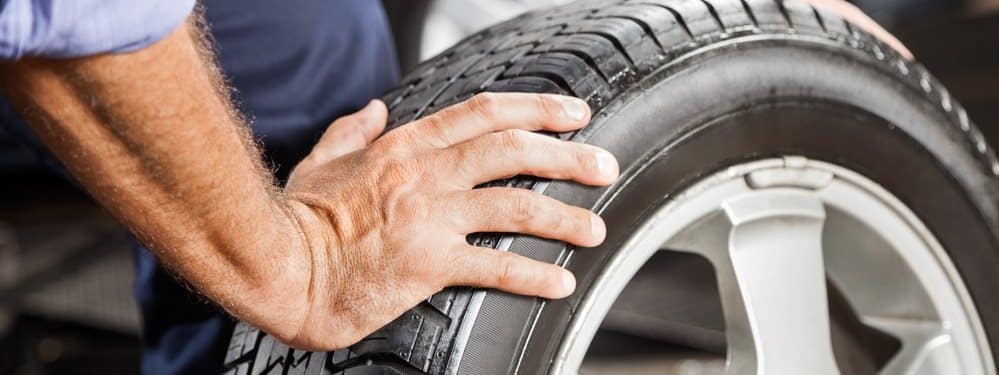 To ensure your safety, measure the tread depth as part of your regular vehicle maintenance.
To ensure your safety, measure the tread depth as part of your regular vehicle maintenance.
Tread is the rubber on the tire that touches the road. New tires have an average tread depth of 8 to 9 millimeters (10/32 to 11/32 inches). As you drive, the tread will wear down. A tire with a tread depth below 1.6 millimeters (2/32 inches) lacks grip. Braking distance and vehicle control are impaired. These tires are not safe for driving and must be replaced.
Please consider that safe driving in wet and snowy weather conditions is affected by the tread depth, the pattern design and the rubber compound of the tread of your tires. On wet or snow-covered roads braking performance will progressively decline with lower tread depths. On wet roads there is an additional increased risk of aquaplaning with fading tread depths.
Therefore, check your tires regularly, reduce your speed on wet and snowy roads and consider replacing your tires in good time.
Ensure your vehicle is equipped with the correct winter, summer, or all-season tires.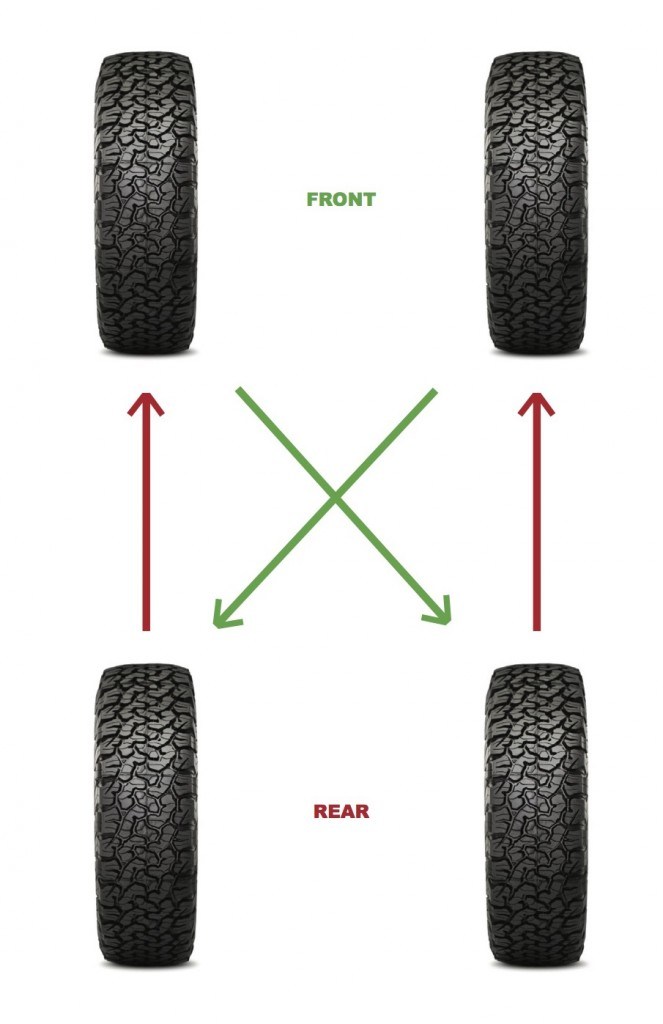
Tread wear indicators, or wear bars, are spaced evenly through the main grooves in the tire tread. If they are flush with the level of the tread, then the tire should be replaced.
Several winter tire models are equipped with winter tire wear indicators. If they are flush with the level of the tread, the tire is no longer suitable for winter driving conditions. In some locations, they may also no longer legally qualify as winter tires.
The tire tread grips the road and wears down as you drive. To ensure your safety, measure the tread depth as part of your regular vehicle maintenance.
If you have a tire tread depth gauge, use it to measure the tread depth. Insert the probe bar into the groove and push the shoulders flush with the tread. Check the top of the gauge to see the measurement. Alternately, a small ruler can be used.
Be sure to check in various locations. A misaligned wheel may result in uneven treadwear.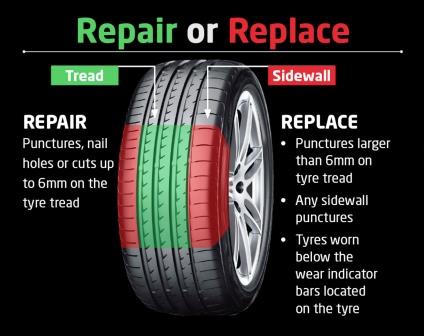 Keep an eye open for any areas that look more worn than the surrounding surface. The tire's tread should be judged by the lowest depth you measured.
Keep an eye open for any areas that look more worn than the surrounding surface. The tire's tread should be judged by the lowest depth you measured.
If you are uncertain of the measurements, take your vehicle to a service center.
While measuring the tread, look for cupping, or scalloping. These are small scoops, or divots, carved from the tread. They can indicate misalignment or other problems with your vehicle. Take your car to a service center.
Also, watch out for bulges in the tire tread or sidewall. They are not safe. You need to get a new tire.
Please enable JavaScript in your browser to display pages properly.
8 (800) 707-65-40
Request a call
Remind password
Personal account
New customer
3 + 9 = I hereby confirm that I have read and agree to the terms of the privacy policy and consent to the processing of my personal data.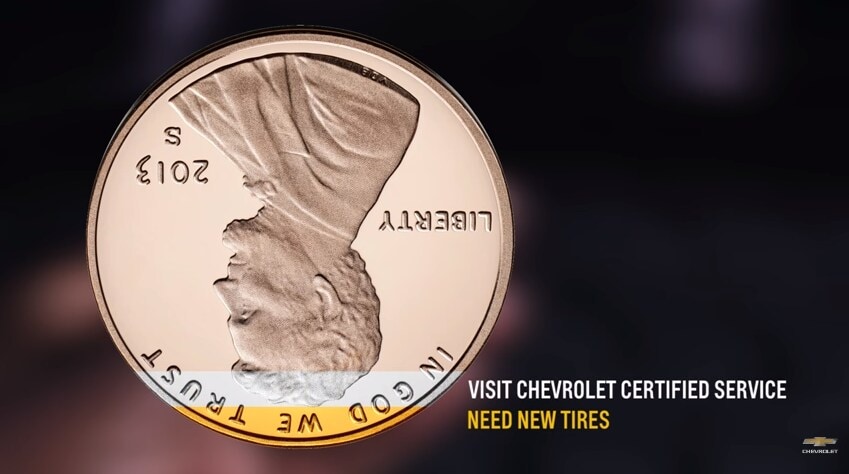 Learn more
Learn more
Request a call
Leave your phone number and a convenient time to call, and we will call you back
Shopul. Komsomolskoye highway, 3b st. Business, 7st. Vaneeva, 209Aul. Golubeva, 7 st. Karl Marx, 60 vul. Comintern, 39, room 1st. Generala Ivlieva, house 24Aul. Fuchik, 36, Perekhodnikova st., 28/1 st. Dyakonova, 2 r. Gaugelya 2A/2pr. Gagarina, 37b 2 + 7 =I hereby confirm that I have read and agree to the terms of the privacy policy and consent to the processing of my personal data. Learn more
The tread depth determines the quality of car tires, their characteristics, predict how the tire can perform in various driving situations. To select a reliable rubber model, you need to figure out what the recommended values \u200b\u200bof the tread pattern of various types of tires are.
The pattern on car tires differs from the operating conditions in which the intended vehicle will be. What are the reasons for the existence of this pattern layer on the bus?
What are the reasons for the existence of this pattern layer on the bus?
The tread depth of new summer tires varies in the region of 6-8 mm. This degree is set by the tire manufacturer.
The main targets for tires in the summer are:
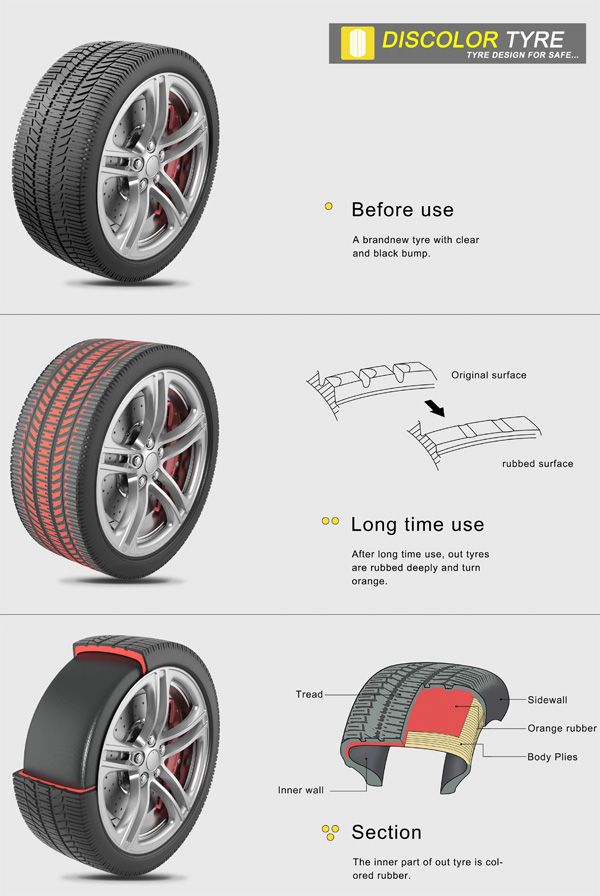
To become the owner of a set of tires that will suit the nature of driving a motorist, you need to pay attention to the following points:
For tires designed for cold weather, there are several indications for tread depth. There are several types of winter tires, the meanings of which are different:
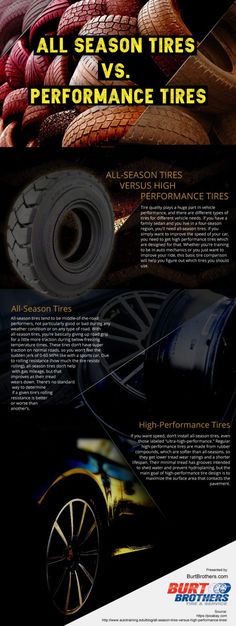
Complain
Thank
Online store KOLOBOX
The most important parameter for any driver is the depth of the tire pattern. Great importance is given to this parameter due to the peculiarities of using tires, because the level of grip with the road surface directly depends on the height of the pattern and, as a result, the safety of the car and the driver on the road.
Contents
Specialists classify tires depending on the season.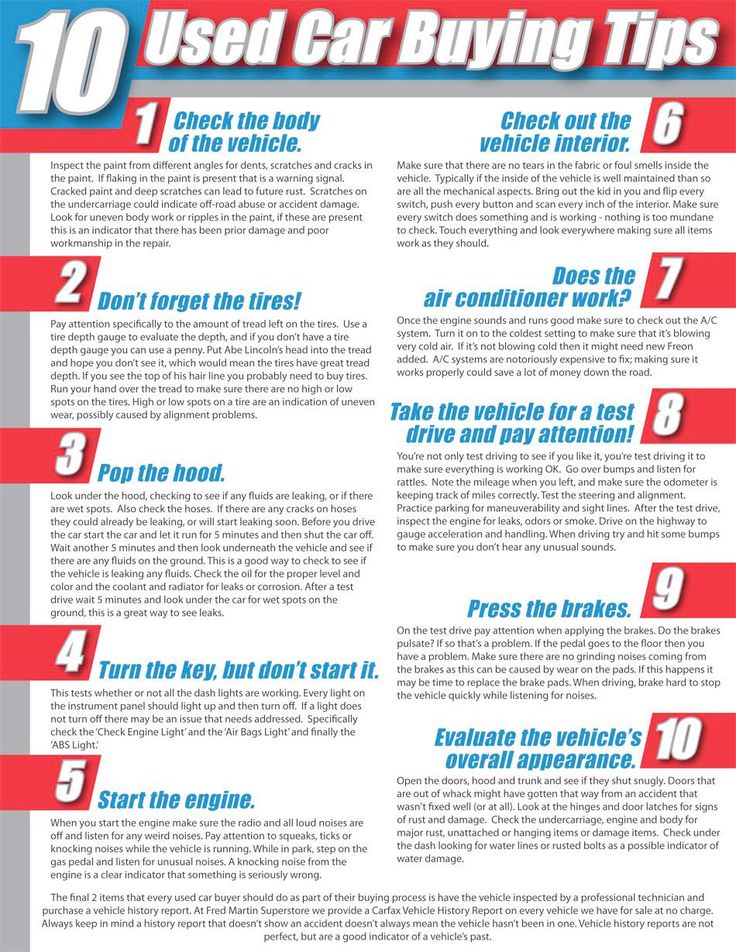 Highlight:
Highlight:
Depending on the characteristics of the new rubber and pattern, the height of the tire at different times of the year provides the maximum level of grip on the road surface. It depends on the characteristics of operation, what is the minimum tread depth on summer tires.
Rubber is usually classified on the basis of the type of transport for which it is intended. For passenger cars, the following types of rubber are distinguished:
In addition, the tread height and pattern features depend on the purpose of the wheels. Which rubber is suitable for operation is determined depending on its type:
The height of these types of tires varies quite a lot. The height of off-road tires can reach up to 17 mm, and the level of sports tires up to 5 mm.
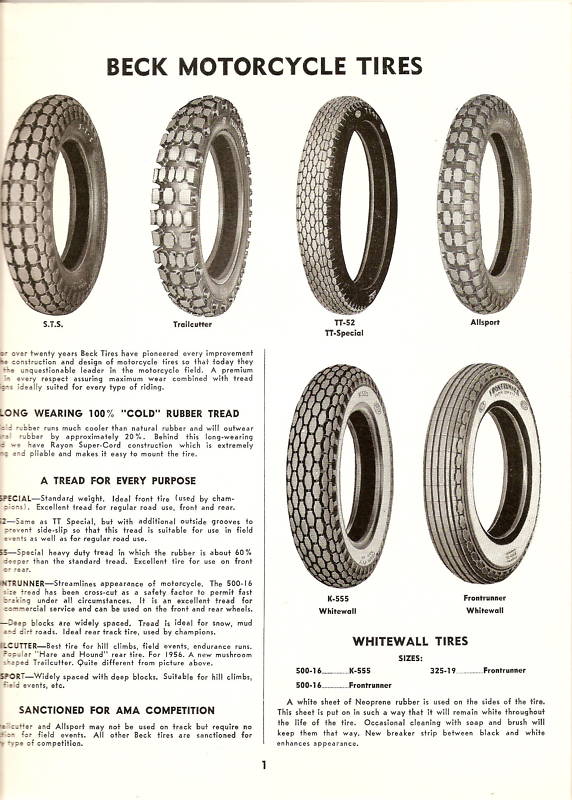
Summer products with a classic symmetrical tread pattern are considered a universal tire model. This pattern is characterized by a moderate removal of liquids from the points of maximum contact with the road. Tires with this pattern provide normal handling of the car on any surface. Additionally, they are characterized by:
For a quiet ride in the city, the purchase of such a new rubber is ideal.
Fans of speed should give preference to tires with an asymmetric tread pattern. Such products will provide reliable grip with the road surface when cornering and driving at high speed.
Tires with this pattern are characterized by the following characteristics:

Stability is achieved by stiffer blocks located on the outer side of the tire. And improved drainage is provided by expanded channels. However, such products have a significant drawback - a significant cost.
For driving in difficult weather conditions, it is worth buying tires with a directional pattern. The peculiarity of the products lies in the fact that the width and depth of the drainage channels significantly reduces the rigidity of the outer rim of the rubber, which reduces its directional stability. Features of the pattern cause a significant difference in the installation of the wheels, which complicates the replacement process. Also, such products are characterized by a rather high noise level.
Height and pattern have a direct impact on such an indicator as the strength of the adhesion of the car to the road, as well as the level of water drainage.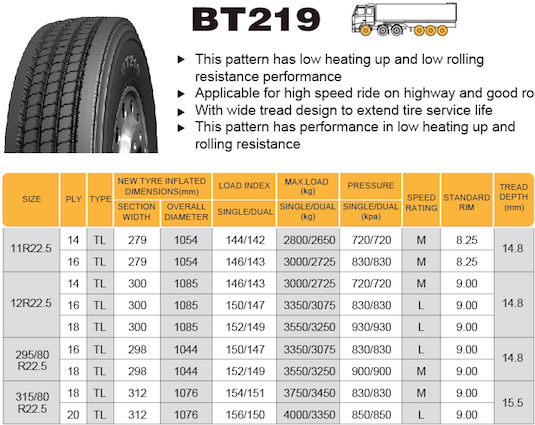 The tread height of new summer tires should be between 6 and 8 mm. A wear level of not more than 50% is allowed. When answering the question, what is the tread depth on summer tires, it is worth noting that its minimum level should be 1.6 mm. This is the maximum allowable amount of wear.
The tread height of new summer tires should be between 6 and 8 mm. A wear level of not more than 50% is allowed. When answering the question, what is the tread depth on summer tires, it is worth noting that its minimum level should be 1.6 mm. This is the maximum allowable amount of wear.
For such tires, the main condition for normal operation is the presence of a tread pattern. Reducing the level of its depth reduces the performance of the product and contributes to a decrease in the quality of liquid drainage. The answer to the question of what percentage tire wear can be is determined depending on the type of car.
The tread depth of new summer tires may vary depending on the purpose of the vehicle. Therefore, answering the question, what is the permissible tread depth on summer tires, it is worth noting that in sports models this figure can reach 17 mm. Large depth indicators are also predetermined for off-road vehicles.
The tread depth for products intended for the winter period is an extremely important indicator.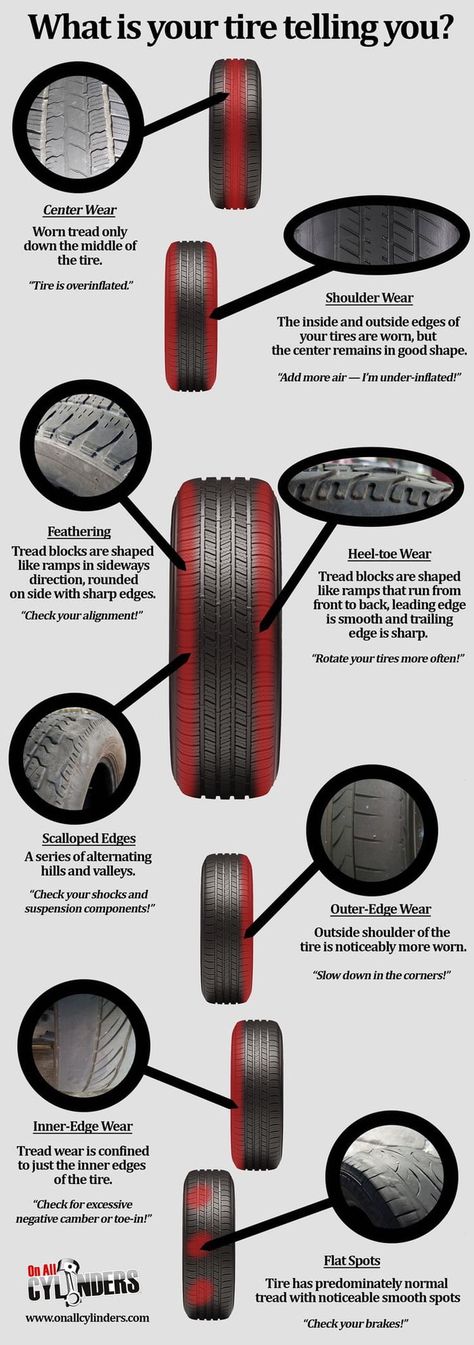 In summer, driving on dry roads allows significant wear on the pattern, while in winter, safety directly depends on its depth.
In summer, driving on dry roads allows significant wear on the pattern, while in winter, safety directly depends on its depth.
Winter tires are divided into several types:
This type of tire was developed for driving in severe frosts and snowfalls. Answering the question, what should be the tread height of passenger tires in comparison with this, then it should be 8 mm, which is quite significant. This type of tire is characterized by an asymmetric pattern. Rectangular cups are designed to act on snow and ice, which are removed from the contact surface with the help of lamellas.
Studs provide traction by breaking up snow and ice. Such rubber can also be used for driving on asphalt, however, it makes quite a lot of noise. Hard braking can damage the studs.
This type of tire is suitable for driving in mud and slush, as well as light snow conditions.